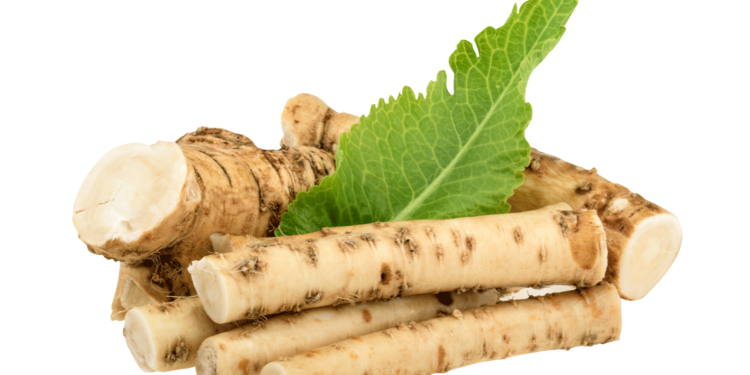On a beautiful autumn day, I came home to visit my parents and walked into the kitchen to see my mom and aunt with puffy eyes with tears running down their blushed cheeks. I gasped, “What’s wrong, did someone get hurt or die?”
Mom managed a grin and sputtered out, “No, we are grinding our horseradish!” On the kitchen table in front of them was the hand grinder and some kind of long whitish roots.
Horseradish is a perennial root crop related to mustard, cabbage and broccoli. It is believed the long tapered white root vegetable got its name in the 1590s. ‘Horse’ was used to describe something strong or coarse, and ‘radish’ for a similar root crop. Horseradish has been known since ancient times. A mural depicting the vegetable was found in the ruins of the Roman city of Pompeii. American Indians used it to treat colds. Both George Washington and Thomas Jefferson grew them in their gardens. Today, horseradish is used as a condiment. In many countries it is used on meat to add the spicy hot flavor.
Horseradish can be grown as a perennial in zones 2-9. After the first frost, the roots are dug up. Intact roots have little odor and don’t become strong and pungent until they are cut or chopped up. Part of the roots are replanted for next year’s crop. Left undisturbed they can become invasive, but over time the roots become woody and can’t be used as an edible vegetable. Horseradish likes growing in full sun with loamy, fertile soil. Many gardeners plant the roots in bottomless buckets submerged in the garden to limit the spread of the roots. Plant the roots about 18 inches apart and at a 45-degree angle, three to four inches deep. Keep the area weed free, water regularly, fertilize throughout the growing season and keep an eye out for bugs like the cabbage worms and flea beetles that like to chew on plants in the cabbage family.
Horseradish has four times the vitamin C than oranges. It is 20 times richer in calcium than potatoes and packed with iron, potassium, magnesium and other minerals. It is important to remember the same horseradish that burns your tongue, makes you sweat and tear up, can also irritate the lining of your gut if too much is consumed!
Usually, horseradish is grated and added to vinegar, mayo, or mustard. Some like it strong, while others can’t handle the heat and desire a milder recipe. If horseradish is a big thing for you, there is an International Horseradish Festival every June in Collinsville, Illinois. You can take part in a root toss or enter into a horseradish recipe contest. The area around Collinsville grows 60% of the world’s horseradish supply!
Personally, I am a big wimp when it comes to hot and spicy foods. A week ago, I accidentally bought a bottle of mustard laced with horseradish. Thinking it was honey mustard, I liberally smeared the yellow condiment all over my turkey. I took a big bite and thought I had set fire to my tongue, throat, eyes and nose! The bottle went to the trash! If you want to spice up your life and introduce something new and bold to your tongue, growing horseradish is for you!


